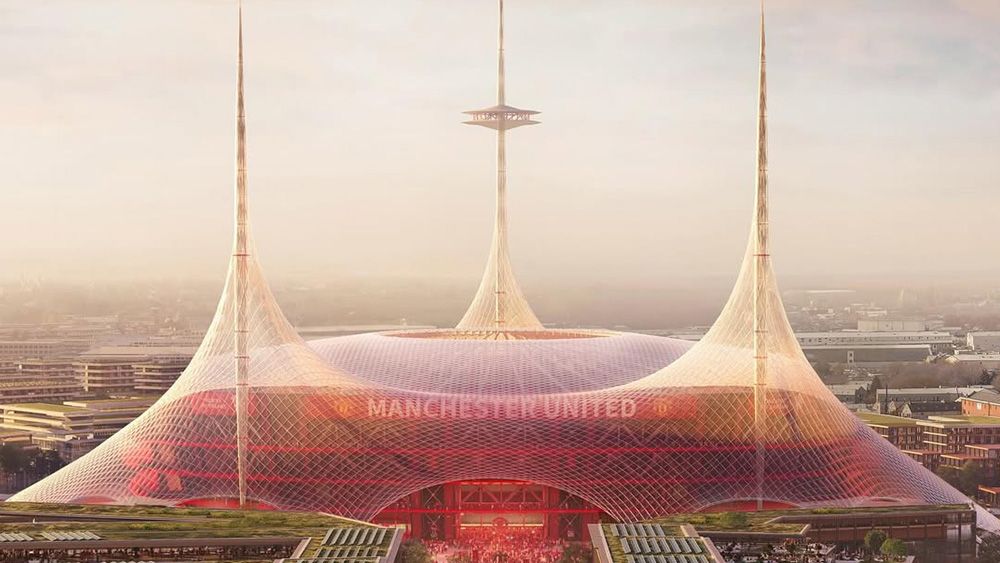Manchester United recently announced plans to build an entirely new stadium.
The parking lot next door to Old Trafford has been earmarked for the construction, which will cost an estimated $2.6 billion.
The 100 000-seater will be the second largest in the world, after Camp Nou, and also among the most hi-tech.
There is some irony to this, coming mere weeks after news of the closure of the Manchester United staff canteen.
Such is life amid the rarefied air of club ownership.

South Africa, meanwhile, is tilting at windmills, writes Clinton van der Berg on his Got Game website.
There has been some talk of another bid for the Olympic Games, a wildly optimistic ambition given the state of public services, chiefly roads, water and electricity.
Not to mention stadiums, the last of which was built in 2009.
‘Worrying signs of wear and tear’
Already Moses Mabhida, completed that year, is showing worrying signs of wear and tear.
The $450 million edifice dominates the Durban skyline, but the damage is such that city fathers recently allocated R236 million for its refurbishment.
Cape Town Stadium is almost 16 years old, but it’s a bygone relic compared to some of the stadiums subsequently built in the US and Europe.
Given the state of the economy, its $600 million cost seems almost quaint.
Newlands, meanwhile, resembles a swamp. Time for the bulldozers and developers to move in.
FNB Stadium was built in the late 1980s and given a massive revamp in 2009 to come up to scratch as a venue for the 2010 FIFA World Cup.
With a 90 000-plus capacity, it’s seldom full, but as a symbol of South Africa’s sporting prowess, it is suitably oversized, resplendent and monolithic.
Ellis Park is the most storied (and oldest) of SA’s stadiums, having been built almost 100 years ago and then torn down and rebuilt in 1982.
Sixteen years ago, ahead of the 2010 FIFA World Cup, it was spruced up to the tune of R450 million.
But the great venue has issues.
While it remains a splendid locale with a world class playing surface, it has lost its appeal among fans on account of it being on the wrong side of town.
The Lions have worked hard with the city to enhance the game-day experience for big fixtures, to much success, but regular match days can be like running the gauntlet.
While many SA stadiums were built as vanity projects – typically oversized and intimidating – evolving consumer habits suggest a scaling down would better serve South African interests.
Crowds have diminished on account of a tough economy, ordinary match day experiences and sweeping television coverage.
With few exceptions, sellouts at rugby, football and cricket are the exception to the rule.
There has been chatter in popular corners of Johannesburg about the Lions being better off building a more compact stadium somewhere like Midrand or even near the Wanderers where plans for a massive sporting hub were drawn up some years ago, yet remain in cold storage.
Community stadiums
The UK model is perhaps the best to emulate with 12 000 to 15 000-seat community stadiums all across the country.
Domestic matches pack the places out and for really big derbies or finals, somewhere like Twickenham is booked to satisfy the interest.
You could imagine this working for a team such as the Lions, although the stumbling block is obviously the estimated cost of R450 million to R600 million to build a similarly sized stadium.
The Lions don’t have significant debt – Ellis Park is jointly owned by the City of Johannesburg, Orlando Pirates, Interza Lesego, and Ellis Park Stadium – and would presumably run a mile at the prospect of raising that sort of cash.
The only way to do so would be in partnership with the city, or they could perhaps consider the progressive Green Bay Packers option.
The team itself is publicly owned through shares, which have helped fund various renovations to Lambeau Field.
Even Barcelona’s Camp Nou was modernised via a public share scheme, which allowed fans to become shareholders.
The new $1.75 billion Las Vegas Stadium, scheduled for completion in 2028, is funded through a combination of public and private sources.
South Africa is packed with creative minds and you could envisage someone crafting a formidable plan to reimagine the Lions in a fresh, compelling new setting that is fit for purpose.
Renting space to business tenants
Happily, the Wanderers has moved with the times by diversifying and renting out space to business tenants.
The cricket facility has also become a vibrant multi-use venue, much like Loftus Versfeld up the road in Pretoria, which makes far more money from religious gatherings and music festivals than via rugby.
The 2027 Cricket World Cup will take place in South Africa, but fortunately capital expenditure will exclude stadiums.
South Africa is well set with cricket venues, some of which require little more than a lick of paint.
In Johannesburg, significant indoor venues are a bust.
The original Dome is now a car dealership, although even in its previous incarnation it never quite did the job.
The Ellis Park Arena is tired and irrelevant and out of place.
Top-end hotels tend to accommodate expos and the like, but they always seem what they are – temporary and make-do.
Interestingly, Stadium Management SA, which runs FNB Stadium, recently opened “The Dome”, a 6000㎡ indoor venue (capacity 10 500) adjacent to FNB.
It’s been heralded as a music venue, but it wouldn’t take a great leap to stage some boxing or MMA there, perhaps even tennis.
The significant thing is that it was constructed at all given the fatigue that set in after 2010 notwithstanding its far more modest cost and dimensions.
Joburg likes to think of itself as a modern city, but its creaking infrastructure and laissez faire attitude among city fathers paint a truer picture.
Of neglect and indifference.
What’s the best stadium in South Africa (for any sport)?
Let us know by leaving a comment below, or send a WhatsApp to 060 011 021 1
Subscribe to The South African website’s newsletters and follow us on WhatsApp, Facebook, X and Bluesky for the latest news.
